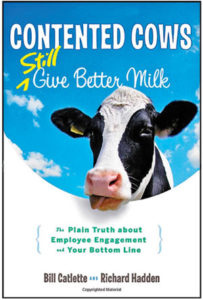In his book Moments of Truth, Jan Carlzon, former CEO of the Swedish airline SAS, states that “An individual without information cannot take responsibility. An individual who is given information cannot help but take responsibility.” If we want those who fuel the success of our businesses, our workers, to be more engaged in that success, there are at least five questions that we, as leaders, must answer for every person on the payroll.
1. Where are we going as an organization?
One thing we’ve learned from studying successful businesses, large and small, over the last two decades, is that “mission is motivating.”
I’m not talking about a “mission statement” but rather a sense of mission – something that connects with workers at an emotional level and drives their daily decisions as to how much of themselves they’re willing to invest in somebody else’s business, namely yours.
Simply put, if people don’t know full well where your ship is headed, they can’t possibly help you get there.
People want to know, “Are we going to the moon by the end of the decade?” as President Kennedy so clearly answered in the early ’60s. “To the Super Bowl by 2015?” “Are we planning to grow the business, diversify or be the best in our current niche at our current size (which is OK, too)?”
2. What are our most important business priorities?
Comparatively speaking, business owners spend entirely too much precious time and energy crafting precisely worded mission, vision and value statements – time and effort they should be investing in making sure every human being in the outfit truly understands and appreciates what’s really important to make the business, and them, successful. (If you know of a way to do one without the other, long-term, let me know.)
Here’s the key question: Does every person on your payroll understand the three or four most important priorities that drive your operation?
If not, you may well have a company full of hardworking, well-meaning but unfocused people working with great energy on so many varying priorities that nothing reaches critical mass.
For example, there’s no doubt about the top priorities at Toronto’s Maple Leaf Sports and Entertainment . The diversified company owns four professional sports teams as well as the Air Canada Centre , Canada’s premier sports and entertainment venue. The company operates on four clearly articulated priorities:
• Excite every fan.
• Inspire our people.
• Be dedicated to our teams.
• Be leaders in our community.
These four priorities (not eight or 10 and that’s important) are taught to every associate, whether that associate’s trade tools be a mop and broom, a meat thermometer or highly technical television production equipment. Every decision, at every level, is placed against the backdrop of these four priorities.
If something helps the company excite every fan, inspire their people, be dedicated to their teams or be leaders in the community, it’s deemed, in most cases, to be a good idea – if not, it probably won’t happen.
But what really makes this work for MLSE is that the company reinforces these priorities in their internal communications, their leadership practices and, perhaps most importantly, their reward system.
As an example of just one small part of the company’s recognition process, each month, four “stars” are named – people whose work that month has most exemplified one of the four stated priorities.
As a leader or business owner, it’s incumbent on you to be clear about your top few priorities and then to practically carpet-bomb your organization with what those priorities are – then reinforce them.
How? Make sure your own behavior consistently reflects, and never violates, those priorities – and, just as Maple Leaf does, reward those who demonstrate their commitment to those priorities.
3. What’s so important about what I do every day?
The moment someone begins to entertain the slightest notion that what they do isn’t very important, they can’t possibly put themselves fully into their work.
This happens when we, as leaders, compromise quality standards – ask people to do tasks the fruits of which we never use, when we take them and their work for granted and, most importantly, when we fail to help people make the connection between their job and the customer – the person who consumes and pays for the product they make.
You’ve got workers who do important work but who never encounter the paying customers who buy your dairy products. So how can you help them make the connection? Sometimes we have to do it in demonstrable and compelling ways.
A few years ago, I was consulting with a company whose people made consumable hospital products. There was a huge disconnect between the factory workers and the critical importance of the work they did. Hence quality suffered, turnover was high and so were production costs.
Once we took the workers on a tour of a nearby hospital where they saw, with their own eyes, the products they’d made with their own hands saving lives, their perspective changed, quality soared and turnover and other costs leveled off.
Do your people know how their work touches the people who buy your products? Why it’s important that they do it well every day? What happens when they don’t? If not, tell them. Better yet, show them.
4. How am I doing?
This is perhaps one of the most critical information needs any employee has and yet far too many workers operate in total darkness when it comes to understanding how their performance stacks up.
I’m again reminded of Jan Carlzon’s words, “An individual without information cannot take responsibility. An individual who is given information cannot help but take responsibility.”
There are lots of reasons that managers often fail to give helpful, honest feedback to the people they work with. Among them:
• They don’t want to hurt people’s feelings or demotivate them. But let’s be clear – one of the unkindest things any manager can do is to fail to tell someone their performance is subpar, thereby depriving them of the opportunity to correct their course before crashing into the rocks.
• It’s easier not to – both from a time and emotional perspective.
• Managers are under the mistaken impression that giving feedback can only take place as a formal, written evaluation.
• They aren’t prepared to share specifics but instead have only a vague feeling that the employee isn’t cutting it. That won’t cut it.
It doesn’t take hours – only seconds or minutes – to tell someone how they’re doing. A word of encouragement, when they’re on the right track but not there yet; a heartfelt thank-you for going above and beyond; and a clear and bone-honest assessment of work that misses the mark – can all keep or turn performance, both individual and organizational, in the right direction, at an ever-more-productive velocity.
5. How does this business make money?
Every commercial enterprise exists to make a profit. I know ours does. It’s the only way to ensure survival, and there’s no need to apologize for it.
And yet, an informal and unscientific poll our company has conducted for years convinces us that fewer than 5 percent – that’s 5 percent – of employees have the first clue about how their company earns, spends and invests its money. “It’s none of their business!”
I sometimes hear from business owners. My reply, “Then make it their business … and you’ll see business improve.”
One of the most powerful things you can do to help people take responsibility for helping you earn a profit is to educate everyone, from the part-time entry level worker to the top of the house, as to what it takes to make money in your business.
Where does the money come from? Where does it go? What does it cost to earn it? Without this information, people are likely to conclude that the money is easily earned and can therefore be easily spent.
Jack Stack, founder and CEO of Springfield Remanufacturing Corporation , pioneer of the concept of open-book management and author of The Great Game of Business , writes that every employee should be given the measures of business success and taught to understand them. Further, they should be expected and enabled to act on their knowledge to improve performance.
Plamex , the Mexican division of headset maker Plantronics, subscribes to a form of open-book management and has reaped tremendous rewards in terms of profitability, efficiency and employer reputation.
2012 marked the second consecutive year in which the company was named the #1 Best Place to Work in Mexico by the international Great Place to Work Institute.
“Everyone who works here has access to almost everything there is to know,” company president Alejandro Bustamante told me, when I visited the company’s Tijuana manufacturing facility. “The only exceptions are patents, salaries and anything restricted by Plantronics corporate.”
Plamex associates can see the company’s strategic plan and observe how the plant is performing against it.
Sales, cost, scrap and all sorts of other production data is made available in terms that anyone, from the assembly worker to the CFO, can understand. Even the minutes of the weekly senior leadership meeting are laid out for all to see.
If you pay for any portion of your employees’ health care coverage or life insurance, do they have any idea what these benefits cost?
What about the employer’s contribution to a 401(k) or other retirement plan? Or training, both in-house and offsite? Don’t gloat or rub people’s faces in this, but if you’re paying for these benefits, you should get emotional credit for your contribution.
One question I often get when talking about open-book management or any of its variations is: “What happens when my people find out how much I make compared to them?”
The answer can be complex. In the first place, I’m not sure you need to share that information in order to fulfill your commitment to educating people about the company’s finances. Plamex doesn’t and neither do many others who do equally well in this area.
If your workers are paid fairly, it’s likely not to be a burning question. On the other hand …
A critical concept here is that of entrepreneurialism. Reward for risk. When workers truly understand that owners are paid not only for their labor but for their risk, issues of compensation disparity tend to fade. One suggestion: Give everyone – everyone – the opportunity to participate in profits and losses – and watch the sense of responsibility soar. PD
Hadden is co-author of the new book Contented Cows Still Give Better Milk. His company conducts leadership training and employee surveys.

Richard Hadden
Co-founder Contented Cow Partners, LLC






